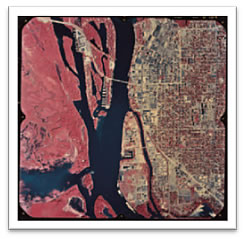To develop a data set that would allow for focused analyses at site-specific areas, true color (TC) and color infrared (CIR) aerial photography were collected in the late-summer of 1989 at a scale of 1:15,840. This was a ground-breaking effort to classify almost three million acres of the Upper Mississippi and Illinois River floodplains to the genus-level. The classification system was based on identifiable species, ccurring alone or mixed. To provide additional information, modifiers were added to these map classes that described vegetation density, or relative cover, and, in the cases of trees, a height modifier. Initially, it was unknown whether TC or CIR film would best for vegetation mapping and this is the reason that both formats were collected. Though submersed vegetation could be distinguished slightly better using TC, all other vegetation showed greater distinction using CIR and this was the format used to generate the 1989 LCU dataset.
 Film was sliced into individual frames and thin, clear pieces of mylar were taped to each frame. Neat lines were drawn on each mylar overlay to delineate the area being interpreted and then fine-tipped technical ink pens were used to draw vegetation types called polygons. Each polygon received a unique label describing its land cover or land use type and, if necessary, a modifier describing its density and height. Adjacent photos were tied together so the polygons extending beyond the neat lines aligned were carried over to the next overlay.
Film was sliced into individual frames and thin, clear pieces of mylar were taped to each frame. Neat lines were drawn on each mylar overlay to delineate the area being interpreted and then fine-tipped technical ink pens were used to draw vegetation types called polygons. Each polygon received a unique label describing its land cover or land use type and, if necessary, a modifier describing its density and height. Adjacent photos were tied together so the polygons extending beyond the neat lines aligned were carried over to the next overlay.
This information was transferred to 1:24,000-scale USGS topographic base maps and then digitized into a computer. Topo map-based data sets were joined together to create larger navigation pool-based data sets. These final maps were checked for spatial and label errors, then posted to UMESC’s web site for use by LTRMP partners as well as the general public.
More detailed information on this process is available in the PDF located at:http://umesc.usgs.gov/documents/reports/1995/95p00801.pdf